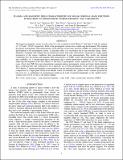| dc.contributor.author | Liu, Ying D. | |
| dc.contributor.author | Hu, Huidong | |
| dc.contributor.author | Wang, Rui | |
| dc.contributor.author | Yang, Zhongwei | |
| dc.contributor.author | Zhu, Bei | |
| dc.contributor.author | Liu, Yi A. | |
| dc.contributor.author | Luhmann, Janet G. | |
| dc.contributor.author | Richardson, John D. | |
| dc.date.accessioned | 2015-11-24T17:52:48Z | |
| dc.date.available | 2015-11-24T17:52:48Z | |
| dc.date.issued | 2015-08 | |
| dc.date.submitted | 2015-07 | |
| dc.identifier.issn | 2041-8213 | |
| dc.identifier.issn | 2041-8205 | |
| dc.identifier.uri | http://hdl.handle.net/1721.1/100031 | |
| dc.description.abstract | The largest geomagnetic storms of solar cycle 24 so far occurred on 2015 March 17 and June 22 with D[subscript st] minima of -223 and -195 nT, respectively. Both of the geomagnetic storms show a multi-step development. We examine the plasma and magnetic field characteristics of the driving coronal mass ejections (CMEs) in connection with the development of the geomagnetic storms. A particular effort is to reconstruct the in situ structure using a Grad–Shafranov technique and compare the reconstruction results with solar observations, which gives a larger spatial perspective of the source conditions than one-dimensional in situ measurements. Key results are obtained concerning how the plasma and magnetic field characteristics of CMEs control the geomagnetic storm intensity and variability: (1) a sheath-ejecta-ejecta mechanism and a sheath-sheath-ejecta scenario are proposed for the multi-step development of the 2015 March 17 and June 22 geomagnetic storms, respectively; (2) two contrasting cases of how the CME flux-rope characteristics generate intense geomagnetic storms are found, which indicates that a southward flux-rope orientation is not a necessity for a strong geomagnetic storm; and (3) the unexpected 2015 March 17 intense geomagnetic storm resulted from the interaction between two successive CMEs plus the compression by a high-speed stream from behind, which is essentially the "perfect storm" scenario proposed by Liu et al. (i.e., a combination of circumstances results in an event of unusual magnitude), so the "perfect storm" scenario may not be as rare as the phrase implies. | en_US |
| dc.description.sponsorship | China. Recruitment Program of Global Experts | en_US |
| dc.description.sponsorship | National Natural Science Foundation (China) (Grant 41374173) | en_US |
| dc.description.sponsorship | State Key Laboratories of China (Specialized Research Fund) | en_US |
| dc.language.iso | en_US | |
| dc.publisher | IOP Publishing | en_US |
| dc.relation.isversionof | http://dx.doi.org/10.1088/2041-8205/809/2/l34 | en_US |
| dc.rights | Article is made available in accordance with the publisher's policy and may be subject to US copyright law. Please refer to the publisher's site for terms of use. | en_US |
| dc.source | IOP Publishing | en_US |
| dc.title | PLASMA AND MAGNETIC FIELD CHARACTERISTICS OF SOLAR CORONAL MASS EJECTIONS IN RELATION TO GEOMAGNETIC STORM INTENSITY AND VARIABILITY | en_US |
| dc.type | Article | en_US |
| dc.identifier.citation | Liu, Ying D., Huidong Hu, Rui Wang, Zhongwei Yang, Bei Zhu, Yi A. Liu, Janet G. Luhmann, and John D. Richardson. “PLASMA AND MAGNETIC FIELD CHARACTERISTICS OF SOLAR CORONAL MASS EJECTIONS IN RELATION TO GEOMAGNETIC STORM INTENSITY AND VARIABILITY.” The Astrophysical Journal 809, no. 2 (August 20, 2015): L34. © 2015 The American Astronomical Society | en_US |
| dc.contributor.department | MIT Kavli Institute for Astrophysics and Space Research | en_US |
| dc.contributor.mitauthor | Richardson, John D. | en_US |
| dc.relation.journal | The Astrophysical Journal. Letters | en_US |
| dc.eprint.version | Final published version | en_US |
| dc.type.uri | http://purl.org/eprint/type/JournalArticle | en_US |
| eprint.status | http://purl.org/eprint/status/PeerReviewed | en_US |
| dspace.orderedauthors | Liu, Ying D.; Hu, Huidong; Wang, Rui; Yang, Zhongwei; Zhu, Bei; Liu, Yi A.; Luhmann, Janet G.; Richardson, John D. | en_US |
| mit.license | PUBLISHER_POLICY | en_US |
| mit.metadata.status | Complete | |
